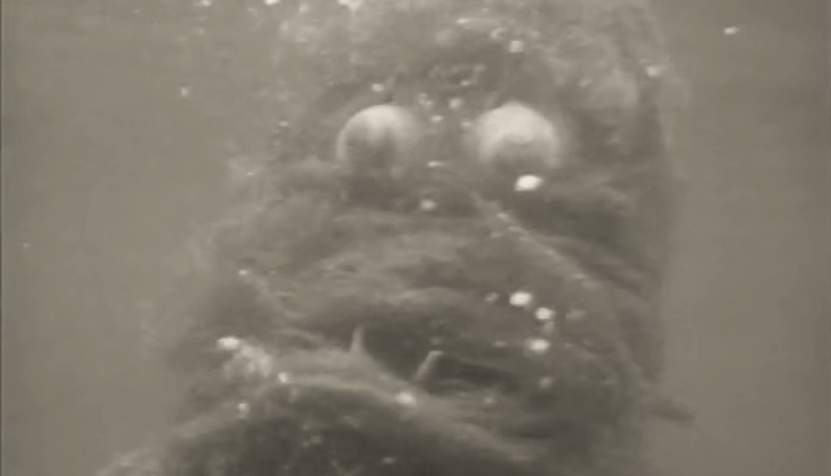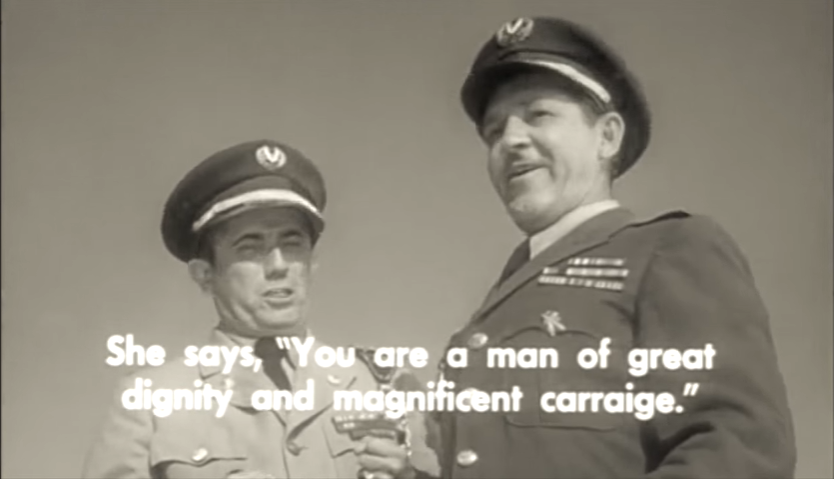
By the early sixties, much of the movie industry had moved on from creature features, and Roger Corman was no different—he had already started the Poe cycle (with The Pit and the Pendulum premiering just two months after this post’s subject), which are the more highly-regarded among his directorial efforts. Still, while in this transition period, Corman was experimenting with his horror movies, and starting with 1959’s A Bucket of Blood, we started to see them become out and out comedies with a ghoulish or monstrous twist. Creature From the Haunted Sea is the last of these horror-comedies, and the one that is the most like a parody of his own low budget B-movies from the fifties, which could probably be chalked up to the fact that it more or less reuses the story from the 1959 movie Beast From Haunted Cave, which he produced (and itself was more or less recycled from a non-monster movie Naked Paradise—all three variations written by Attack of the Crab Monsters‘ Charles B. Griffith), with a different setting, monster, and with added comedy. Also, like most of Corman’s movies, it had a low budget, was filmed extremely quickly (five days!), and was made basically because they had extra time during their Puerto Rico location shoots for two other movies. Although mostly an underground phenomenon since its release, you may recognize this movie and the titular googly-eyed monster from its cameo appearance in the opening of Malcolm in the Middle. But as goofy-looking as the monster is, the movie is pretty consistently funny even when it’s not around, showcasing a dialogue-based absurdity that overcomes the obvious budgetary limitations.

The basic premise for each level of the copy-of-a-copy script is a heist gone wrong, with this welding together crime, espionage, and monster flicks into a mildly clever mash-up. The hero and narrator of Creature is an American agent codenamed XK150 (played by future Chinatown scriptwriter Robert Towne, under the name Edward Wain), who is tasked with infiltrating the ship crew of gangster Renzo Capetto (Antony Carbone, who had previously appeared in A Bucket of Blood) after he has made a deal with Cuban counterrevolutionary forces to smuggle a chunk of that country’s treasury abroad. So yes, this is set during a specific point in history, and we get caught up with what happened during the Cuban Revolution in cartoon form, which was nice of them to include. The Cuban crew have gone to Capetto because “as an American gambler and gangster, [he] is above suspicion”, but of course he immediately begins making plans to make off with the valuables. Alongside his primary crew, which includes his best girl Mary-Belle (Corman regular Besty Jones-Moreland), her dumdum brother Happy Jack (played by the movie’s boom operator Robert Bean, who replaced Corman himself in the role after Griffith intentionally wrote the character to be as unwieldy as possible just to annoy him), and Pete Peterson Jr., a man who mostly talks by making stock animal noises, Capetto decides to knock off the Cubans one by one and pretend that a mysterious “monster” is behind it all. His low-rent implements for this plot include a muddy plunger and a few rakes. Unbeknownst to him, there actually is a creature in the haunted sea (also played by Bean), who begins killing people at the same time. An improvisational series of crosswired plots and setbacks occur (the treasure sinks to the sea bottom, leading to several scuba diving scenes probably filmed in the same marine park tank that appeared in Attack of the Crab Monsters, and a lot of easy pickings for the monster), with the agent, going by the name “Sparks Moran”, being too much of a dimbulb to really stop any of them, while also being distracted by his attempts to “save” Mary-Belle, who makes it quite clear that she is completely uninterested in him. She also clearly loves her life of crime, because she’s shown to be gambling in almost scene she’s in.

For the most part, the plot of this could be taken entirely straight (and, in fact, had been), and rather than try to make the story itself absurd, the script instead fills it with absurd characters, conversations, and moments. As I said, this is likely because Corman’s miniscule budgets don’t allow for a lot of big visual gags (I was surprised at the number of extras in this movie compared to the previous two, until I learned that most of them were locals being paid a dollar a day), so most of it has to come from the actors in one way or another. In an early scene, when XK150 escapes some assassins and then disguises himself with a silly-looking fake moustache and accidentally stumbles on some stairs while exiting a scene, you begin to see just what kind of movie you’re getting into. It has to do a lot with a little.

Even if it can’t do the pure off-the-wall nonsense of later spoof movies, it’s brand of comedy manages to bring to mind the captions of a Mad Magazine parody. Towne’s character sleepily narrates the entire movie, punctuating scenes with his poor-man’s-noir readings of lines like “It was dusk…I could tell because the sun was going down” (made even funnier because they don’t even try to shoot day-for-night.) There’s plenty of simple physical humour like that earlier scene, such as one ship passenger who smacks his head on a low ceiling every time he is awoken by an alarm. There’s nonsensical, proto-Airplane jokes like XK150 building radios from things like hot dogs and pickles, the conveniently-located payphone on a beach, or the entire character of Pete Peterson Jr. For the most part, though, the humour relies on—and I’m going to be brutally blunt here—tomfoolery, and the fact that every character other than Capetto and Mary-Belle are complete dimwits who say and do stupid things all the time, although those two have plenty of funny moments as well (in a scene where XK150 narrates the history of Capetto while he puts a gun together, it ends with a spring flying out with a cartoon “sproing!”, which was apparently not in the script.) This isn’t exactly high-brow, but unlike lesser comedies, the jokes are clever enough and come at a nice enough clip that I was entertained throughout most of the seventy-five minute running time, and it only really slows down in pace right at the very end during the final “monster kills off all the remaining members of the cast” sequence.

One of the sections that feels the most like its edging towards later spoof movies is when, after a few monster attacks, the ship has to take a detour to a small island, where the male crew are almost instantly paired off with local women. The scene where Pete discovers the love of his life, a middle-aged woman who also makes stock animal sounds (unfortunately named Porcina), is one of those super silly moments that work really well, as is the scene where her daughter Mango describes her tourist-fleecing scam in Spanish to the unaware and smitten Happy Jack. Meanwhile, a local woman has her sights set on XK150/Sparks, who mostly ignores her while desperately chasing Mary-Belle, but in the end decides she’s good enough. I don’t know if I can defend any of this as being super-smart comedy, or ahead of its time (it’s portrayal of women is probably only slightly better than you’d expect from a early sixties B-movie), but like I said, it’s silly and consistent, and at least it never allows a ton of humour-free dead air to kill the mood. The closest thing to filler this movie has is a musical sequence (where the title of the movie is inexplicably dropped in the lyrics) in the middle of it, which was apparently filmed years later because the movie wasn’t long enough for TV airings (can you imagine it, a movie being too short for TV?), and even that has someone getting hit with a fish and a good joke where Mary-Belle stops singing and it sounds like they just powered down a record player.

In fact, probably the one place that could have used more comedy was the stuff with the monster. Don’t get me wrong, the thing can get by on looks alone, as it visually resembles a giant walking Brillo pad with tennis ball eyes, the ultimate realization of every cheaply-made, non-scary monster suit that ever stalked the lesser entries in the fifties creature feature lineage. It’s funny to me that, at least according to the quotes on the Wikipedia page, most of the actors thought the monster was TOO dumb-looking even for this comedy film, which just feels like the attitude from a time before people found intentionally poorly-made costumes inherently hilarious. In any case, I just feel like the charmingly dopey quality of the monster would have benefited from more acting from it, some more little goofy movements or hand gestures while it systematically murdered everyone, playing off the artifice of it. It’s those kinds of things that really make a fake-looking monster stand out, and while we can all cheer for him when he ultimately wins in the end, I was just hoping for more, is all.

I won’t argue that Creature From the Haunted Sea is an artistically-accomplished movie, even as a parody, but like the previous Corman movies, it has an infectiously agreeable energy that raises it above its chintzy production values. It’s a silly movie without pretensions, but given that all of these sorts of monster movies are inherently silly no matter what they do, it’s slightly clever and subversive just by choosing to make everything as absurd as the monster itself. It works as both a send-off and a send-up of Corman’s decade-spanning stay in the genre.

